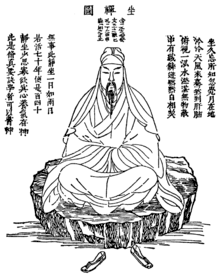Buddhism and Eastern religions
Buddhism has interacted with several East Asian religions such as Confucianism and Shintoism since it spread from India during the 2nd century AD.

Confucianism
Confucianism in particular raised fierce opposition to Buddhism in early history, principally because it perceived Buddhism to be a nihilistic worldview, with a negative impact on society at large. "The Neo-Confucianists had therefore to attack Buddhist cosmological views by affirming, in the firstplace, the reality and concreteness of the universe and of man."[1]
Shintoism
Before Prince Shotoku made Buddhism the national religion of Japan, many opposed the integration of Buddhism into Japan. Once this forced integration occurred, Japan synchronized Buddhism with its native religion Shinto, resulting in a unique sect of Buddhism existing only on the East Asian Island.[2]
In the Japanese religion of Shinto, the long coexistence of Buddhism and Shintoism resulted in the merging of Shintoism and Buddhism. Gods in Shintoism were given a position similar to that of Hindu gods in Buddhism. Moreover, because the Buddha Vairochana's symbol was the sun, many equated Amaterasu, the sun goddess, as his previous bodhisattva reincarnation. According to Helen Hardacre, by the Heian period, a theory named wakō dōjin (和光同塵) had emerged. The Buddha and Kami had taken on a new form as saviors of man, who "dim their light and mingle with the dust of the world". This not only relates the two religions, but demonstrates a marked difference in status between the two deities at this period in time.[3] The later Tokugawa Shogunate era saw a revival of Shinto, and some Shinto scholars began to argue that Buddhas were previous incarnations of Shinto gods, reversing the traditional positions of the two religions. Shinto and Buddhism were officially separated during the Meiji Restoration and the brief, but socially transformative rise of State Shinto followed. In post-war modern Japan, most families count themselves as being of both religions, despite the idea of "official separation".
As time went on, the Japanese became more and more accustomed to including both the kami and Buddhist ideas in their spiritual lives. Philosophers put forward the idea that the kami were "transformations of the Buddha manifested in Japan to save all sentient beings".[4]
In addition, Buddhism played an important part in the religious legitimation of Japanese emperors via Shintoism.
It is noteworthy that the Sui were the first Chinese dynasty with which the newly emergent centralising Japanese state came into contact, so the practice of using Buddhism as an officially sanctioned religion would have been demonstrated to the Japanese as a political reality.[5]
The interplay between Taoism, Buddhism, and Shinto in China and Japan stimulated the adoption of the Chinese practice of state-sanctioned religion and religious legitimation through association with divinity by the Japanese government. The official implementation of the term tennō (天皇) to refer to the Japanese emperor is also widely agreed to take place during the latter part of the 7th century, as a result of these interactions.
Taoism
The relationships between Taoism and Buddhism are complex, as they influenced each other in many ways while often competing for influence. Taoism in its early form was a mixture of early mythology, folk religion, and Taoist philosophy. The arrival of Buddhism forced Taoism to renew and restructure itself into a more organized religion, while addressing similar existential questions raised by Buddhism. Early Buddhism was sometimes seen as a kind of foreign relative of Taoism and its scriptures were often translated into Chinese with Taoist vocabulary. Ch'an Buddhism in particular holds many beliefs in common with philosophical Taoism.
Daoist (Taoist) simplicity stimulated Chan's abandonment of Buddhist theory and was accompanied by another traditional Daoist feature—the emphasis on total absorption in practice of a highly cultivated skill.[6]
See also
- Buddhism and Christianity
- Buddhism and Hinduism
- Buddhism and Jainism
- Buddhism and psychology
- Buddhism and science
- Buddhist ethics
- Buddhist philosophy
- God in Buddhism (Buddhism, mysticism, and monotheism)
References
- Early Neo-Confucian View of Chinese Buddhism
- The Synchronization of Shinto and Buddhism in Japan Archived May 16, 2012, at the Wayback Machine
- Hardacre, Helen, 1949-. Shinto : a history. New York. ISBN 978-0-19-062171-1. OCLC 947145263.CS1 maint: multiple names: authors list (link)
- Shinto history: BBC Religions
- Shinto in history : ways of the kami. Breen, John, 1956-, Teeuwen, Mark. Honolulu: University of Hawaiʻi Press. 2000. ISBN 0-8248-2362-1. OCLC 43487317.CS1 maint: others (link)
- Taoism and Buddhism Archived 2012-05-22 at the Wayback Machine
Further reading
- Arthur F. Wright, (1971) Buddhism in Chinese History, Stanford University Press, Stanford California.
- Tang Yijie, (1991) Confucianism, Buddhism, Daoism, Christianity, and Chinese Culture, University of Peking, The Council for research in values and philosophy
- Christine Mollier, (2008) Buddhism and Taoism Face to Face: Scripture, Ritual, and Iconographic exchange in Medieval China, University of Hawaii Press.
- Fung Yu-Lan and Derk Bodde (1942),The Rise of Neo-Confucianism and Its Borrowings From Buddhism and Taoism, Harvard Journal of Asiatic Studies
External links
- Selfhood and Identity in Confucianism, Taoism, Buddhism, and Hinduism: Contrasts With the West
- The Influence of Confucianism and Buddhism on Chinese Business
- |Asian Religions -- An Introduction to the Study of Hinduism, Buddhism, Islam, Confucianism, and Tao
- BUDDHISM AND CONFUCIANISM IN CH'I-SUNG'S ESSAY ON TEACHING (YUAN-TAO)
- The Conception of Language And The Use of Paradox In Buddhism And Taoism
- Relations Among Confucianism, Buddhism and Taoism, and the Development of Chinese Buddhism
- The Fusion of Three Religions and the Self-adjustment of Northern Song's Demoted Literators
- A Study of the Syncretism of the Three Religions from the Evolvement of "Tao"
- An Analysis of How the Fusion of Confucianism, Buddhism and Taoism Reflects in Journey to the West